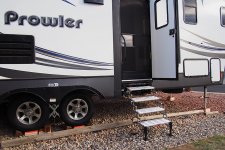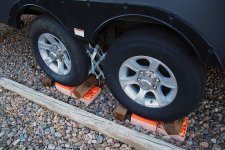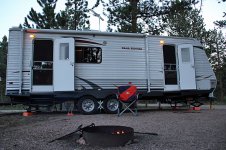JohnD
Moved on to the next thing...
After discovering a separating tread on one of our tires on the way back from the Las Vegas National HOC Rally last October, I've been wondering if this could be an issue.
Typically when we roll into an RV park or campground and I install the X-Chocks, after the tires cool off some I have to snug them up some.
Then a few hours later I have to snug them up again!
And generally the next morning I'll have to do one more snug-up of the X-Chocks.
I love the X-Chocks, but I now wonder if they can damage the tires at all?
Comments anyone?

Typically when we roll into an RV park or campground and I install the X-Chocks, after the tires cool off some I have to snug them up some.
Then a few hours later I have to snug them up again!
And generally the next morning I'll have to do one more snug-up of the X-Chocks.
I love the X-Chocks, but I now wonder if they can damage the tires at all?
Comments anyone?





